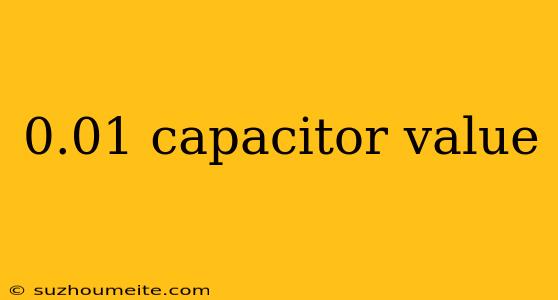Capacitor Value: Understanding 0.01μF
In the world of electronics, capacitors play a crucial role in regulating voltage and current flow. Among the various capacitor values, 0.01μF (10nF) is a common and widely used value in many applications. In this article, we'll delve into the world of capacitors and explore the significance of the 0.01μF value.
What is a Capacitor?
A capacitor is a passive electronic component that stores energy in the form of electric field between two conductive plates separated by a dielectric material. The capacitance of a capacitor is measured in Farads (F), and it determines the amount of energy it can store.
Capacitor Values: Understanding μF and nF
Capacitor values are typically expressed in microFarads (μF) or nanoFarads (nF). The prefix "micro-" represents one millionth, while "nano-" represents one billionth. Therefore:
- 1 μF = 1,000,000 pF (picofarads)
- 1 nF = 1,000 pF
In the case of a 0.01μF capacitor, it's equivalent to 10nF.
Applications of 0.01μF Capacitors
Capacitors with a value of 0.01μF are commonly used in various electronic circuits, including:
Filter Circuits
0.01μF capacitors are often used in filter circuits to block or allow specific frequencies to pass through. In low-pass filters, they help to remove high-frequency noise and allow low-frequency signals to pass through.
Coupling Circuits
In audio circuits, 0.01μF capacitors are used as coupling capacitors to transfer AC signals between stages while blocking DC voltage.
Power Supply Filtering
In power supply circuits, 0.01μF capacitors help to filter out ripple voltage and ensure a smooth output.
Radio Frequency (RF) Circuits
In RF circuits, 0.01μF capacitors are used to tune antennas and filter out unwanted frequencies.
Choosing the Right Capacitor
When selecting a capacitor, it's essential to consider the following factors:
- Capacitance value: Ensure the capacitor value meets the requirements of your circuit.
- Voltage rating: Choose a capacitor with a voltage rating that exceeds the maximum voltage in your circuit.
- Tolerance: Select a capacitor with a suitable tolerance (e.g., ±10%, ±20%) to ensure accuracy.
- Physical characteristics: Consider the capacitor's size, shape, and material to ensure it fits your design.
Conclusion
In conclusion, the 0.01μF capacitor value is a crucial component in many electronic circuits. By understanding its applications and characteristics, you can make informed decisions when designing and building your projects. Whether you're working on a filter circuit, audio circuit, or power supply, a 0.01μF capacitor can play a vital role in ensuring the reliability and performance of your design.
